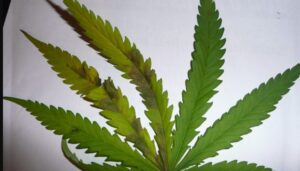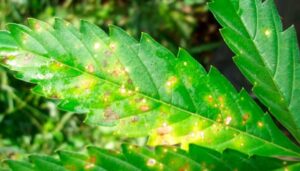We’ve discussed how to develop and when to harvest, as well as dry and wet trimming techniques and best practices. You’ve planted your garden and are monitoring it quite closely, but you see something odd. What do you do now? Looking to try something new? Check out this.
Symptoms Of Cannabis Deficiencies
Many problems in the garden can be traced to three essential elements: the environment, nutrition, and water. Any variation or irregularity in these factors may have a significant influence on your plants’ health. Cannabis deficiencies can manifest themselves on leaves and the plant in a variety of ways, depending on the circumstances.
These symptoms can include:
- Brown or dark spots on the leaves
- Leaves that appear to have “blisters” and/or look glossy
- Leaves turning yellow
- Red or pink coloring on the leaves
- Edges of leaves pointing up
- Leaves falling off
- Burnt tips
- White powdery patches
- Wilting plants
- Etc
The first step in dealing with cannabis deficiencies is to detect them early. The sooner you detect a problem in your garden, the more likely it is that you will be able to remedy it and recover your plant(s).
Causes of Leaf Issues
A cannabis deficiency can develop as a result of stress and go away on its own after the stress has passed. However, certain circumstances may cause a deficit owing to incorrect care or environmental factors. pH imbalances, overwatering plants, and/or nutritional shortages are all possible causes.
Low PH
The Number 1 reason growers see brown marks is because the pH at the roots is too low (typically below 6).
Low pH at the roots was to blame for the following problems. If you don’t use a PH Up solution to correct the problem, some growers may naturally have low pH (acidic) water, which might cause these symptoms. Because certain ingredients or soil can lower the pH level, it’s a good idea to check it even if your water is perfect in terms of chemistry.
When you use a lot of PH Down solution (for example, to bring very high-pH tap water down), these symptoms are likely. Over time, if you use “natural” PH Down like as citric crystals, this might happen.
If you’re not sure if your runoff water is acidic, test its pH. If the water coming out of the bottom of the pot has a significantly lower pH than the water you poured in, it’s a sign that there’s a problem with the roots’ pH.
In this course, you’ll learn how to test and adjust the pH in your garden. This is a fantastic practice to get into since it not only prevents nutritional issues but also might boost plant growth and production by maintaining the proper pH.
Light Burn
Our tomatoes, peppers, and squash were performing wonderfully until we added the two “UFO” design LED grow lights at the top. We wanted to increase harvests by increasing the amount of light in flowering. The maker of these LEDs advised that you may keep them just inches away from the plants.
We had an issue with these cannabis plants for a few days until we added two new LED grow panels on top of the fluorescent lights we were using. We started to notice brown and yellow leaves near the top of the plants. The plants appeared like this several weeks later. We had no clue why it was happening. It must be a nutrient deficiency, we figured.
After I noticed the yellow and brown marks, it became clear to me that the problem was light burn from the grow lights being too close, especially because the discoloration happened right after I installed the two new LED grow lights. Unfortunately, I didn’t make that connection at first. This inexplicable issue plagued me for a second growth cycle. Because I couldn’t figure out what was causing the discolouration, I almost wanted to give up cultivating. Then it hit me: The extreme light from the LED panels was to blame.
All I had to do was move the lights further away. Here’s another illustration of light burn. Look how the symptoms appear toward the top of the plant, but not always on the topmost leaves.
The majority of light damage is caused by LEDs, since they can be kept close without generating much heat. However, under any strong grow light, you may get light burn. While we’re on the subject of light stress, I’d merely mention that yellow leaf tips are another typical indicator of too much lighting (particularly with specific grow lights).
Brown patterns on the leaves are an indication that your grow light is too close. If you see this combined with brown markings, move your grow light farther away to see if the symptoms stop spreading.
Fortunately, the most difficult part of light burn is recognizing it for what it is. Once you’ve made the connection, simply raising your grow light a few inches should do it. I hope you don’t have to go through what I did and spend months wondering why your symptoms are happening.
